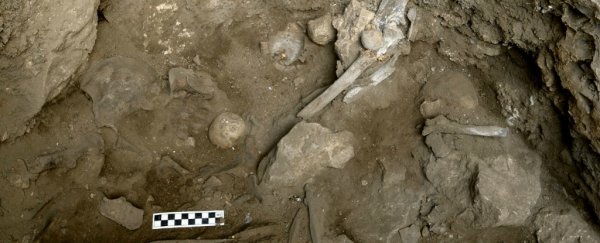After years of analysis, an international team of researchers has pieced together the events of a burial ritual performed for an ancient woman who died in Israel 12,000 years ago.
Based the amount of animal bones found in the grave, the team says the woman - who was 45-years-old when she died - was likely a shaman who was once held in high regard during the Natufian period, which spanned from 15,000 to 11,500 BC.
"The discovery is exciting because it comes from an ancient period when evidence for human ritual practice is beginning to grow. People have just started to settle down into villages and bury their dead on-site," team member Natalie D. Munro from the University of Connecticut told Léa Surugue from the International Business Times.
"Before the late Natufian era," she adds, "burials are much less common in the archaeological record."
According to the team, led by Leore Grosman from Hebrew University in Israel, the woman was found back in 2005 inside Hilazon Tachtit Cave in northern Israel, along with 28 other graves, though none of the others were buried like the suspected shaman.
Unlike the other graves inside the cave, which were pretty standard burials, the woman's was separated by a giant piece of stone, layered with gravel, seashells, 86 tortoise shells (likely the remnants of a feast), and all kinds of other animal skulls and bones ranging from the pelvis of a leopard to the wing of an eagle.
"She was buried with a unique suite of animal remains that often figure in the toolkits of modern day shamans around the world," Munro explained to IBTimes.
"She was also old and was born with deformations in her spinal column and hip. All of these things are commonly associated with ritual practitioners, thus these three elements support the hypothesis that she was a shaman."
For the team, these findings are evidence that the woman's burial was painstakingly planned out, down to the smallest detail, requiring a bunch of people with a vast array of skills to lend a hand in pulling it off.
"The significant pre-planning implies that there was a defined 'to do' list, and a working plan of ritual actions and their order," Grosman told The Times of Israel.
This list involved someone gathering up all of those animal skulls, someone building the actual tomb, workers pulling in gravel and sediment, and also someone preparing the body. All in all, there was a lot of work that went into the burial.
To make sense of all of the planning, the team broke everything down into stages "based on field notes, digitised maps, stones, architecture and artefact frequency distributions and concentrations", Grosman said.
The first stage involved first finding where the burial was going to take place (location scouting). Then, the bedrock was carefully excavated so craftsmen could add sediment and limestone to the walls, giving the burial chamber a more constructed look.
Next, during the second and third stage, all of the neat artefacts - skulls, bones, etc. - were added, and then covered with a thin layer of ash, though the team doesn't note why.
During the fourth stage, the body was brought in, and another layer of animal offerings were added on top, reports Mindy Weisberger for Live Science.
With so much preplanning, this single burial is a treasure trove of archaeological discovery because it has to pull from so many different people in the community. Plus, as the authors point out, it is one of the first complex burials ever discovered.
"The remnants of a ritual event at this site provide a rare opportunity to reconstruct the dynamics of ritual performance at a time when funerary ritual was becoming an increasingly important social mediator at a crucial juncture deep in human history," the team explains.
The team hopes that with further research they will know more about how burial became a ritualistic practice.
The team's findings were published in Current Anthropology.
